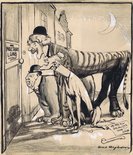Dyson, Will (1880 - 1938)
Will Dyson original cartoon artwork.
Will Dyson was born in Australia, the ninth of 11 children. His first cartoons appeared in the Sydney Bulletin and he came to London in 1909 where he began work for the Weekly Dispatch. A life-long socialist, Dyson began to contribute to The World, a paper produced by a group of striking London printers. The World evolved into the Daily Herald and Dyson became its chief cartoonist, producing a stream of images criticising capitalism, personified as ‘Fat’, a figure with a huge paunch, top hat and cigar. During the First World War, Dyson was an official Australian war artist. In 1919 he produced his most famous cartoon, the prophetic ‘Peace and Future Cannon Fodder’ a critique of the Treaty of Versailles. In the cartoon a crying child, labelled ‘1940 class’ catches the attention of Clemenceau, the French Prime Minister, who remarks, “Curious, I seem to hear a child crying.” Dyson’s wife Ruby died in the post-war Spanish influenza pandemic. He was stricken by her loss and returned to Australia in 1925. Working for the Melbourne papers Herald and Punch he mastered etching and dry point and produced gentle cartoons about local life. But in 1930 Dyson returned to London. On the day he died in Chelsea his last cartoon was published. It shows all his earlier political passion – two vultures watch Franco’s planes bombing Barcelona and one remarks to the other, “Once we were the most loathsome things that flew!”
£1750.00
£1450.00
Epstein: "I may have not done much for art but they can't deny I have done a lot for letters!"
£1450.00
£1550.00
 View Account
View Account




